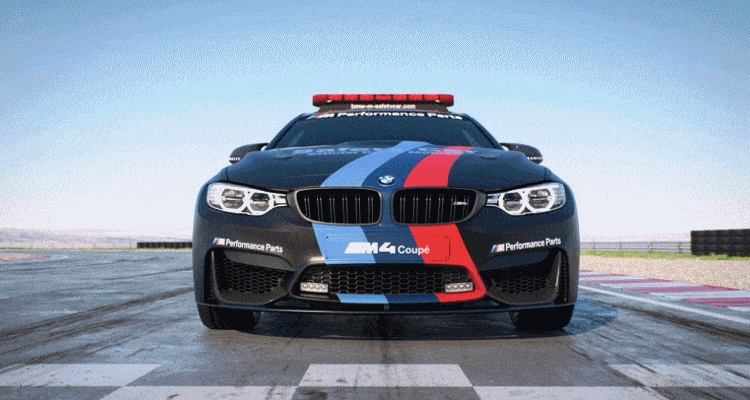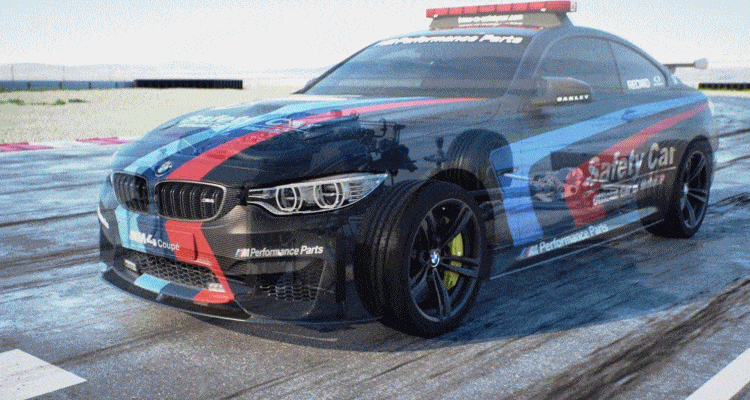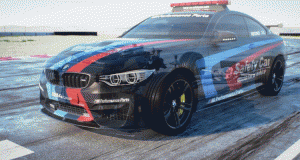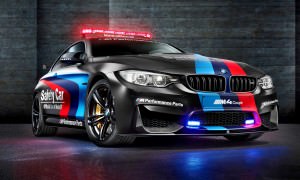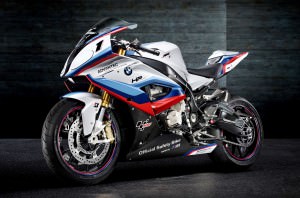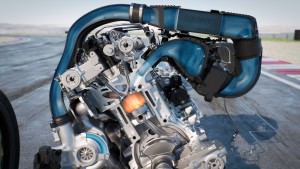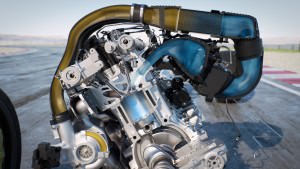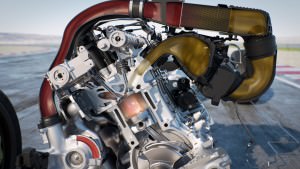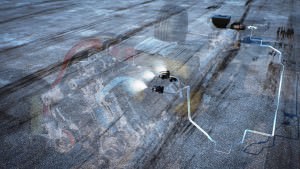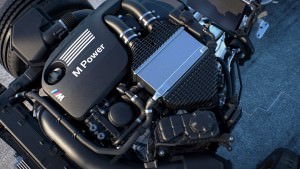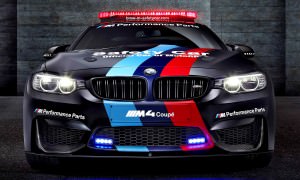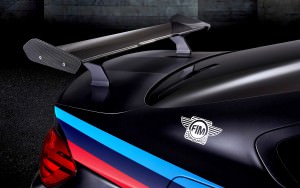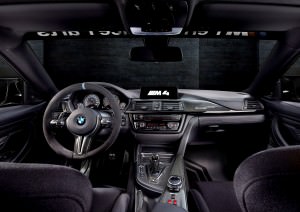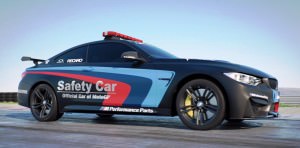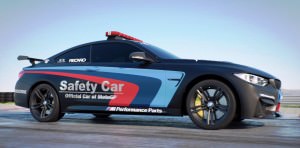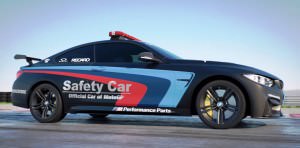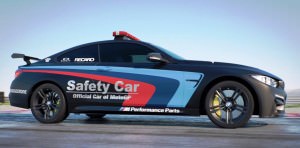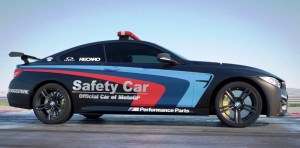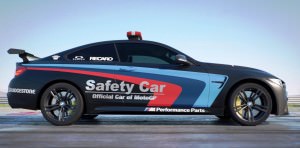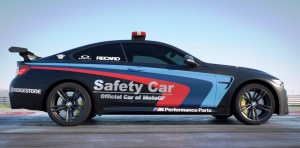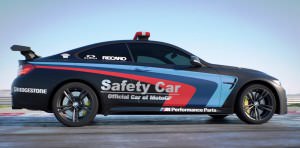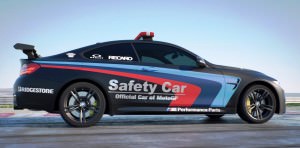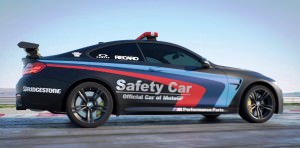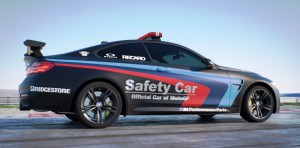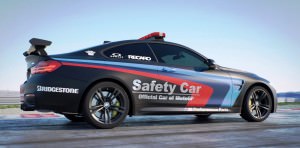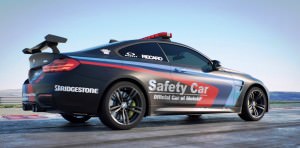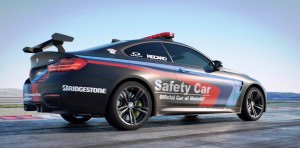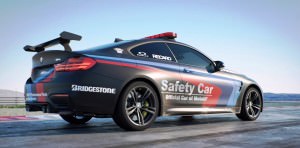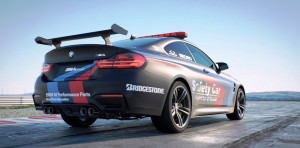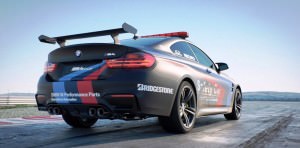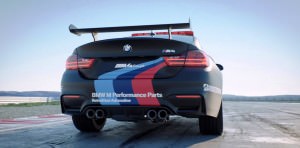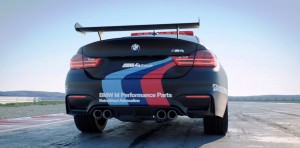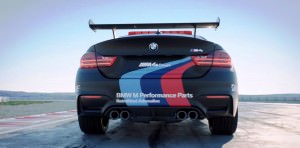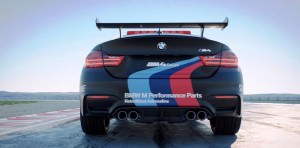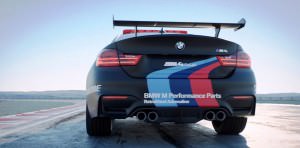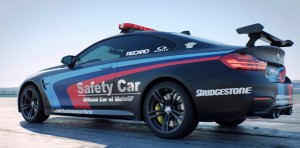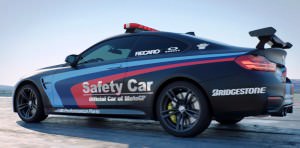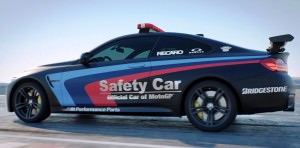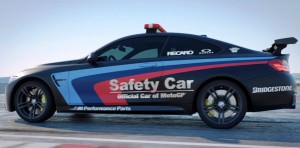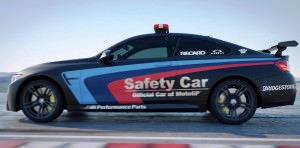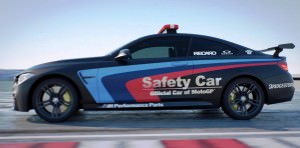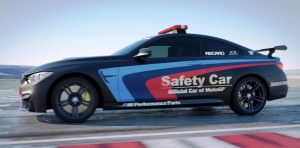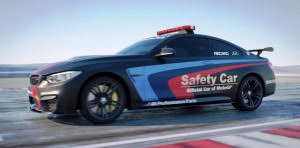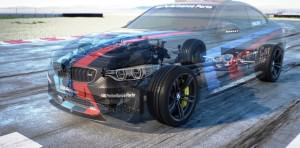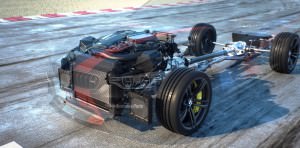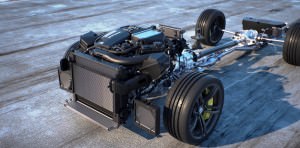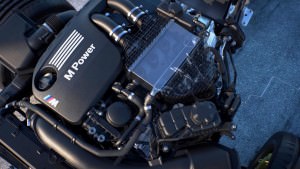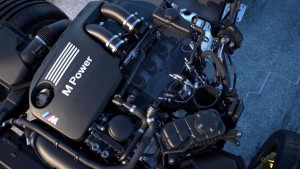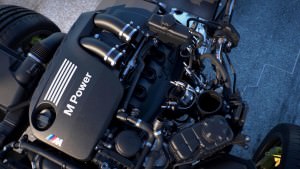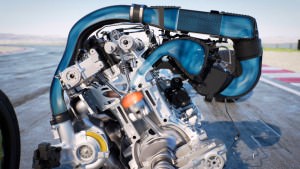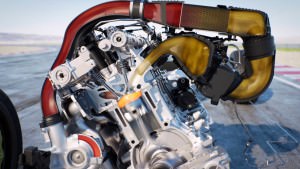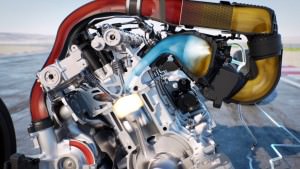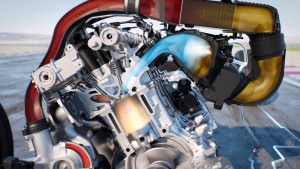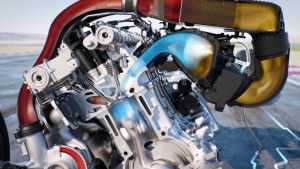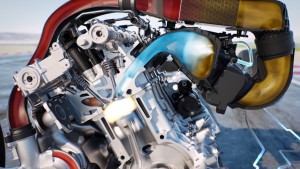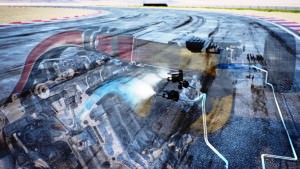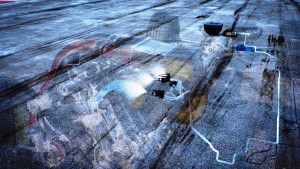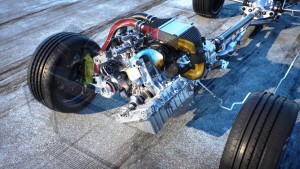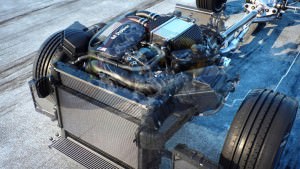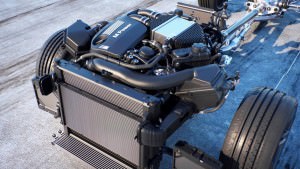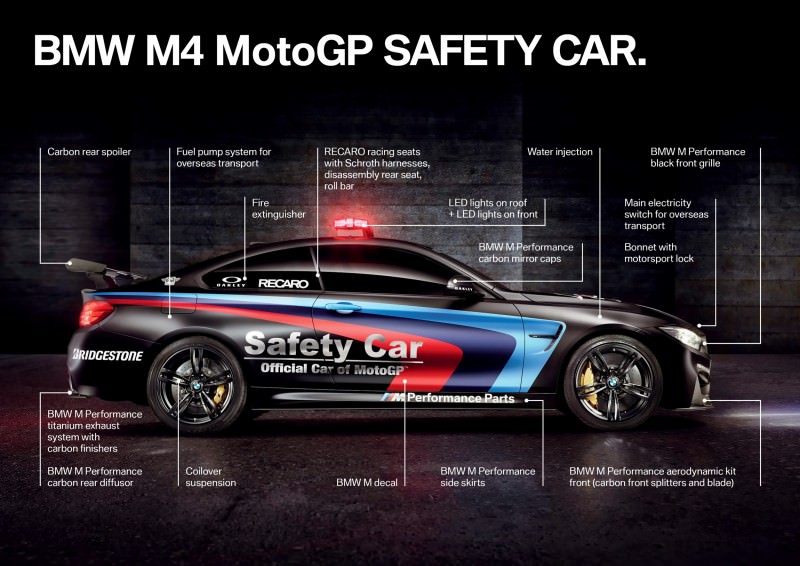 This new M4 MotoGP Safety Car is a beaut in its matte-black finish and artful M-color racing stripes and huge fixed wing atop the trunk.
This new M4 MotoGP Safety Car is a beaut in its matte-black finish and artful M-color racing stripes and huge fixed wing atop the trunk.
But there are two pieces of big news hiding under that pace-car livery: a new water-cooled turbo vaporization technology and the possibility of these upgrades hitting an M4 GTS production model in the next year or so with up to 100 extra horsepower.
First off, the water cooled turbo system. First off, to clarify. Most intercoolers or charge cooler systems actually spray water to the outside of the intercooler itself. Spraying water atop the cooling vanes drops the intercooler temps nicely, and is helpful to avoid a loss of power when making huge boost — and therefore huge heat.
The BMW system is unique by applying a vaporized water blast after the intercooler, but before the turbo boost re-enters the engine combustion cycle. This is a handy way to deliver an optimized boost map that can be crazy intense — and still keep the engine safe for warranty-length use.
Make sense? We had to watch the demo below to really understand. Also screen-capped it throughout to animate it here as a GIF.
The second thing that is exciting? This new tech is very feasible for production cars. It adds almost no extra weight, can be implemented on the same production line, and can achieve up to an extra 100 horsepower or so, depending on the state of the ECU setup.
We believe this new tech will help to juice the upcoming M4 GTS, which may also wear the big MotoGP car’s trunk spoiler as well.
2015 BMW M4 MotoGP Safety Car
BMW M4 MotoGP Safety Car: More power, courtesy of innovative water injection.
Munich. As it did last year, the BMW M4 Coupé will again head the safety Car fleet in the MotoGP World Championship in 2015. BMW M Division’s high-performance coupé has been designed to ensure maximum driving dynamics and with its use on the racetracks of this world in mind. The six-cylinder inline engine with M TwinPower Turbo technology, a high-rev concept and distinct racing genes contributes significantly to the high-performance character of the overall concept. Already in its production version, the sporting heart delivers a top performance of 431 hp (317 kW) and provides a maximum torque of 550 Nm (combined fuel consumption of 8.8-8.3 l/100 km, combined CO2 emissions of 204-194 g/km) over a broadly usable range of revolution speeds.
Technology transfer with potential for the future.
Appearing as it does in the extremely performance-oriented world of MotoGP, where the world’s top motorcycle racers battle for points and positions, the Safety Car must also boast appropriately impressive performance parameters. With this in mind, the engineers at BMW M Division have equipped the high-performance power unit with an innovative water injection, thus considerably increasing the engine’s performance. Water injection makes it possible to raise the upper performance limits, which have otherwise been restricted thermally. As well as increasing performance and torque, the innovative system in the BMW M4 MotoGP Safety Car also ensures outstanding efficiency with benefits in terms of full-load consumption and exhaust emissions. As a BMW M product at the cutting edge of technology and innovation, the BMW M4 MotoGP Safety Car also opens up possibilities for use of this technology in future production models.
Sophisticated cooling system for maximum performance.
placed particularly high demand on the temperature management of the engine and its auxiliaries. In order to guarantee optimal operating temperatures at all times, BMW M Division has turned to a cooling system that is as innovative as it is effective. Next to the main radiator, additional radiators also ensure balanced temperature control for the high and low temperature circuits, as well as for the gearbox and turbocharger. The exhaust air, which is heated by the turbocharger, is cooled using indirect intercooling and is supported by an additional electric water pump.
The kind of increase in performance evident in this year’s BMW M4 MotoGP Safety Car also places even greater demand on the thermal qualities of the turbo engine, particularly the cooling of the supercharged air. This challenge has been overcome using the innovative water injection. As well as significantly increasing performance, the high-performance power unit also boasts outstanding full-load consumption and emission figures.
Following intense testing within the MotoGP World Championship, the water injection system will also be employed in a BMW M production model in the near future. This allows BMW M Division customers to take advantage of high-performance technology straight from the racetrack, which considerably improves performance on the streets and is ideally suited for everyday usage.
Water injection: cooling efficiency increases effectiveness.
The water injection system employed by BMW M Division further optimises the performance and consumption of the charged six-cylinder, inline engine at full throttle. The engineers make use of the water’s physical effect during the vaporisation process to extract the energy required from the environmental medium. Water is injected into the intake module’s collector as a fine spray, thus significantly cooling the exhaust air during vaporisation. This lowers the discharge temperature in the combustion changer and thus reduces the tendency for knocking. The turbo engine can thus be operated with a higher charging pressure and an earlier ignition point.
The lower process temperatures also reduce the formation of hazardous substances, in particular nitrogen oxide (NOX). Water injection consequently dramatically improves the effectiveness of the engine. The technology increases performance and torque, whilst at the same time ensuring outstanding consumption and emission figures. As such, the improved performance can be achieved without increasing the heat applied to performance-related components, meaning the reliability of these parts is not affected.
The advantages of water injection can be used in different ways, depending on the engine and vehicle design. The engineers hereby have relatively free rein to decide to what extent they wish to optimise either the performance or the consumption of the power unit.
Potential for systematic usage.
When a turbo engine whose turbo charger reaches its maximum speed at nominal output is fully charged, additional water injection makes it possible to increase performance and reduce consumption by about eight per cent. At the same time, losses in performance as a result of rising ambient temperatures (> 20 °C) are also compensated by increasing the amount of water being injected. And finally: instead of more performance, water injection can also be configured to reduce consumption, thus allowing more savings when fully loaded.
If water injection is taken into account when designing a high-performance engine, the turbocharger can be implemented with a suitably high degree of supercharging, whilst at the same time achieving a high compression ratio. The result is a substantial increase in performance and the reduction of consumption and emission figures when fully loaded.
The mechanism behind water injection in detail.
The performance achievable by a combustion engine is limited by various factors, including the process temperature in the combustion chamber. If this temperature is exceeded, the result is uncontrolled combustion (knocking) and thus a loss in performance and, in the worst case, expensive damage to the engine. This is particularly important when the engine is charged, as the intake air is already heated intensely in the turbocharger’s supercharger. An intercooler does ensure that the temperature drops as necessary, but even that has its physical limits. Depending on design and dimensions of the cooling system and the car’s aerodynamics, the intake air reaches temperatures that are just below the maximum permitted temperatures.
Increasing the supercharging pressure would exceed the knocking limit and is therefore not a viable means for increasing performance. BMW M Division has a solution: injecting a fine spray of water into the collector once more significantly reduces the temperature of the combustion air. The cooler supercharged air reduces the engine’s tendency to knock, making it possible to bring the point of ignition forward and thus closer to the optimum value. This makes the combustion process more effective, whilst at the same time reducing the combustion temperature. On the other hand, cool air has a higher density which increases the oxygen content in the combustion chamber. This results in a higher mean pressure during the combustion process and in turn optimises performance and torque. Finally, the effective internal cooling of the combustion chamber reduces the thermal strain on numerous performance-related components. This not only prevents damage to pistons, exhaust valves and catalytic converters, but also reduces the strain on the turbocharger, which is subjected to lower exhaust temperatures.
Resolving a conflict of objectives.
Using water injection to increase the knocking limit also helps to largely resolve a familiar conflict in objectives when designing powerful engines. Performance and consumption are not least determined by the compression ratio. This also applies, in particular, to highly charged turbo engines like the BMW M TwinPower Turbo, inline six-cylinder. Thanks to a high compression ratio, this engine is highly efficient and boasts low consumption figures, especially in partial load range. However, the maximum compression ratio is limited by the knocking tendency when fully loaded. Water injection is also hugely beneficial here, as it reduces the tendency for the engine to knock, whilst at the same time increasing the compression ratio. This way, the turbo engine can achieve optimal performance across a wide range of operating points: the potential of the technology increases more, the lower the octane rating of the fuel used. As fuel with ROZ 98 is not available everywhere in the world, water injection helps achieve optimal performance and consumption from an engine with Super E10 (ROZ 95).
Implementing the technology in the BMW M4 MotoGP Safety Car.
When positioning the water injection, the engineers at BMW M Division opted for a layout with three injection valves in the plenum chamber, each supplying two cylinders of the six-cylinder, inline engine. This solution ensures very equal distribution and also allows the system to be designed in a compact manner.
Located in the boot of the BMW M4 MotoGP Safety Car is a water tank with a gross volume of about five litres, which houses the water pump, sensors and valves. The pump and complete system of sensors and actuating elements are controlled by the engine electronics, which have been upgraded accordingly. In practice, the pump feeds the water to the injectors at a pressure of ten bar, whereby the appropriate volume is supplied depending on load, engine speed and temperature. This ensures that water consumption is kept to an absolute minimum. In rigorous action out on the racetrack, it is always necessary to refill the water supply whenever the car must refuel. During standard operation, the intervals between water refills are considerably longer, depending on the driving style. Even when driving faster on the motorway, it is only necessary to refill the water container roughly every five stops for refuelling. To ensure the system is as suitable as possible for daily use, it does not require any additional maintenance.
Maximum system safety.
For safety reasons, the BMW M water injection works with a sophisticated automatic diagnosis. Should the water tank be empty or parts of the system fail, appropriate measures will be taken to protect the power unit. Supercharging pressure and ignition point are cancelled, thus enabling continued operation of the engine without any restrictions other than reduced performance. However, a wide range of measures also ensures the functionality of the system during normal operation. After the engine has been turned off, the water is transported back from the pipeline into the tank, in order to prevent the system components freezing in minus temperatures. The water tank itself is also frost-proof.
Technology transfer from the racetrack to the street.
With water injection, BMW M Division is once again underlining its many years of motorsport experience and expertise when it comes to developing powerful drive trains. The letter “M” is not only synonymous with success on the racetrack, but also with uncompromising high-performance, street-legal sports cars. The BMW M4 MotoGP Safety Car allows BMW M Division to underline its innovative prowess and to follow the brand’s philosophy of bringing motorsport technology to the streets. At the same time, the model also offers a clear perspective of an M car that will set a new benchmark in terms of performance, exclusivity and individuality. As well as greater performance coupled with outstanding consumption and emission figures, customers will also benefit from an innovative water injection system with benefits both on the racetrack and in everyday use.
The BMW Group
With its three brands BMW, MINI and Rolls-Royce, the BMW Group is the world’s leading premium manufacturer of automobiles and motorcycles and also provides premium financial and mobility services. As a global company, the BMW Group operates 30 production and assembly facilities in 14 countries and has a global sales network in more than 140 countries.
In 2014, the BMW Group sold approximately 2,118 million cars and 123,000 motorcycles worldwide. The profit before tax for the financial year 2013 was € 7.91 billion on revenues amounting to approximately € 76.06 billion. As of 31 December 2013, the BMW Group had a workforce of 110,351 employees.
The success of the BMW Group has always been based on long-term thinking and responsible action. The company has therefore established ecological and social sustainability throughout the value chain, comprehensive product responsibility and a clear commitment to conserving resources as an integral part of its strategy.
BMW M – Official Car of MotoGP. Media Guide 2015.
- 13.02.2015
Dear Media Representatives,
The 2015 season marks the 17th season of BMW M as “Official Car of MotoGP”. Ever since 1999, MotoGP organiser Dorna Sports has been able to rely on a dependable partner in the form of BMW M when it comes to ensuring the highest possible degree of safety at the pinnacle of motorcycle racing. This successful partnership has grown consistently over the years. Last autumn, Dorna Sports and BMW M Division extended their cooperation up to and including 2020. This means we will be able to celebrate the 20th anniversary of BMW M in MotoGP in 2019. We are proud of this partnership, which spans over decades and is extremely rare in international, high-performance sports.
BMW M has always been synonymous with technological innovations, and we are delighted to be able to present another new highlight this year: in the near future, BMW M Division will begin production of a model featuring water injection. Water injection is a system designed to increase the performance and reduce the consumption of combustion engines. We will be using this technology in the BMW M4 MotoGP Safety Car for the 2015 season for the first time.
When it comes to leading a field of high-performance racing prototypes safely in any conditions, technology gleaned from the world of motorsport and innovative ideas are indispensable. That is precisely why BMW M is the “most powerful letter in the world”. The new water injection is just one example of this. Outstanding driving properties and impressive performance parameters – this is what allows our high-performance automobiles to master any challenge, whether on the racetrack or in everyday use.
Millions of fans around the world are captivated by MotoGP. Therefore, it provides us with an outstanding opportunity to present our brand, technology and products to an international audience that is enthusiastic about racing. As well as providing a Safety Car fleet featuring the latest BMW M high-performance models, our commitment to MotoGP also includes many other activities. The BMW M Award, which was presented for the first time in 2003, is a much sought-after accolade among the world’s top motorcyclists. The BMW M MotoGP Experience and our BMW M MotoGP Experts allow us to offer our guests an unforgettable weekend of racing with an exclusive insight into what goes on behind the scenes. As if this were not enough, fans at racetracks around the world also have the opportunity to discover the wide world of BMW M at close hand.
This Media Guide offers you an informative overview of our partnership with Dorna Sports and our commitment to MotoGP, as well as the history of BMW M Division and the company’s extensive range of products. Should you have any further queries, it goes without saying that we are only too happy to help. I hope you have an exciting 2015 season!
Frank van Meel
President of BMW M Division

Tom Burkart is the founder and managing editor of Car-Revs-Daily.com, an innovative and rapidly-expanding automotive news magazine.
He holds a Journalism JBA degree from the University of Wisconsin – Madison. Tom currently resides in Charleston, South Carolina with his two amazing dogs, Drake and Tank.
Mr. Burkart is available for all questions and concerns by email Tom(at)car-revs-daily.com.


